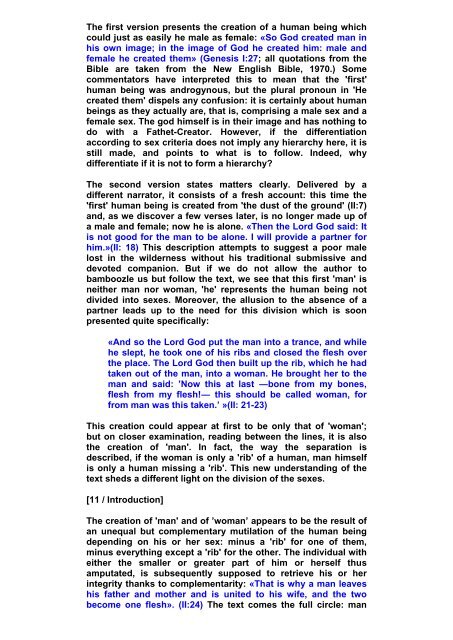emmanuel reynaud holy virility the social construction of masculinity
emmanuel reynaud holy virility the social construction of masculinity
emmanuel reynaud holy virility the social construction of masculinity
Create successful ePaper yourself
Turn your PDF publications into a flip-book with our unique Google optimized e-Paper software.
The first version presents <strong>the</strong> creation <strong>of</strong> a human being which<br />
could just as easily he male as female: «So God created man in<br />
his own image; in <strong>the</strong> image <strong>of</strong> God he created him: male and<br />
female he created <strong>the</strong>m» (Genesis Ι:27; all quotations from <strong>the</strong><br />
Bible are taken from <strong>the</strong> New English Bible, 1970.) Some<br />
commentators have interpreted this to mean that <strong>the</strong> 'first'<br />
human being was androgynous, but <strong>the</strong> plural pronoun in 'He<br />
created <strong>the</strong>m' dispels any confusion: it is certainly about human<br />
beings as <strong>the</strong>y actually are, that is, comprising a male sex and a<br />
female sex. The god himself is in <strong>the</strong>ir image and has nothing to<br />
do with a Fa<strong>the</strong>t-Creator. However, if <strong>the</strong> differentiation<br />
according to sex criteria does not imply any hierarchy here, it is<br />
still made, and points to what is to follow. Indeed, why<br />
differentiate if it is not to form a hierarchy?<br />
The second version states matters clearly. Delivered by a<br />
different narrator, it consists <strong>of</strong> a fresh account: this time <strong>the</strong><br />
'first' human being is created from '<strong>the</strong> dust <strong>of</strong> <strong>the</strong> ground' (ΙΙ:7)<br />
and, as we discover a few verses later, is no longer made up <strong>of</strong><br />
a male and female; now he is alone. «Then <strong>the</strong> Lord God said: It<br />
is not good for <strong>the</strong> man to be alone. I will provide a partner for<br />
him.»(ΙΙ: 18) This description attempts to suggest a poor male<br />
lost in <strong>the</strong> wilderness without his traditional submissive and<br />
devoted companion. But if we do not allow <strong>the</strong> author to<br />
bamboozle us but follow <strong>the</strong> text, we see that this first 'man' is<br />
nei<strong>the</strong>r man nor woman, 'he' represents <strong>the</strong> human being not<br />
divided into sexes. Moreover, <strong>the</strong> allusion to <strong>the</strong> absence <strong>of</strong> a<br />
partner leads up to <strong>the</strong> need for this division which is soon<br />
presented quite specifically:<br />
«And so <strong>the</strong> Lord God put <strong>the</strong> man into a trance, and while<br />
he slept, he took one <strong>of</strong> his ribs and closed <strong>the</strong> flesh over<br />
<strong>the</strong> place. The Lord God <strong>the</strong>n built up <strong>the</strong> rib, which he had<br />
taken out <strong>of</strong> <strong>the</strong> man, into a woman. He brought her to <strong>the</strong><br />
man and said: ’Now this at last ―bone from my bones,<br />
flesh from my flesh!― this should be called woman, for<br />
from man was this taken.’ »(ΙΙ: 21-23)<br />
This creation could appear at first to be only that <strong>of</strong> 'woman';<br />
but on closer examination, reading between <strong>the</strong> lines, it is also<br />
<strong>the</strong> creation <strong>of</strong> 'man'. In fact, <strong>the</strong> way <strong>the</strong> separation is<br />
described, if <strong>the</strong> woman is only a 'rib' <strong>of</strong> a human, man himself<br />
is only a human missing a 'rib'. This new understanding <strong>of</strong> <strong>the</strong><br />
text sheds a different light on <strong>the</strong> division <strong>of</strong> <strong>the</strong> sexes.<br />
[11 / Introduction]<br />
The creation <strong>of</strong> 'man' and <strong>of</strong> ’woman’ appears to be <strong>the</strong> result <strong>of</strong><br />
an unequal but complementary mutilation <strong>of</strong> <strong>the</strong> human being<br />
depending on his or her sex: minus a 'rib' for one <strong>of</strong> <strong>the</strong>m,<br />
minus everything except a 'rib' for <strong>the</strong> o<strong>the</strong>r. The individual with<br />
ei<strong>the</strong>r <strong>the</strong> smaller or greater part <strong>of</strong> him or herself thus<br />
amputated, is subsequently supposed to retrieve his or her<br />
integrity thanks to complementarity: «That is why a man leaves<br />
his fa<strong>the</strong>r and mo<strong>the</strong>r and is united to his wife, and <strong>the</strong> two<br />
become one flesh». (ΙΙ:24) The text comes <strong>the</strong> full circle: man
















